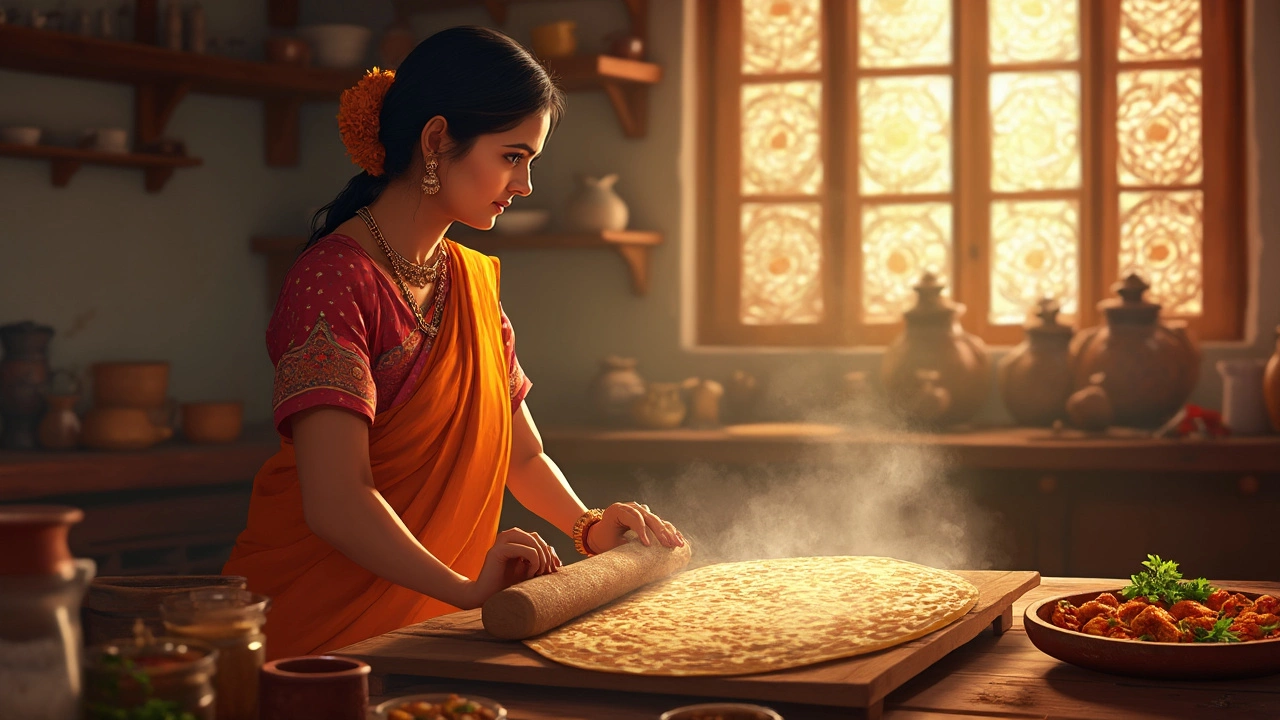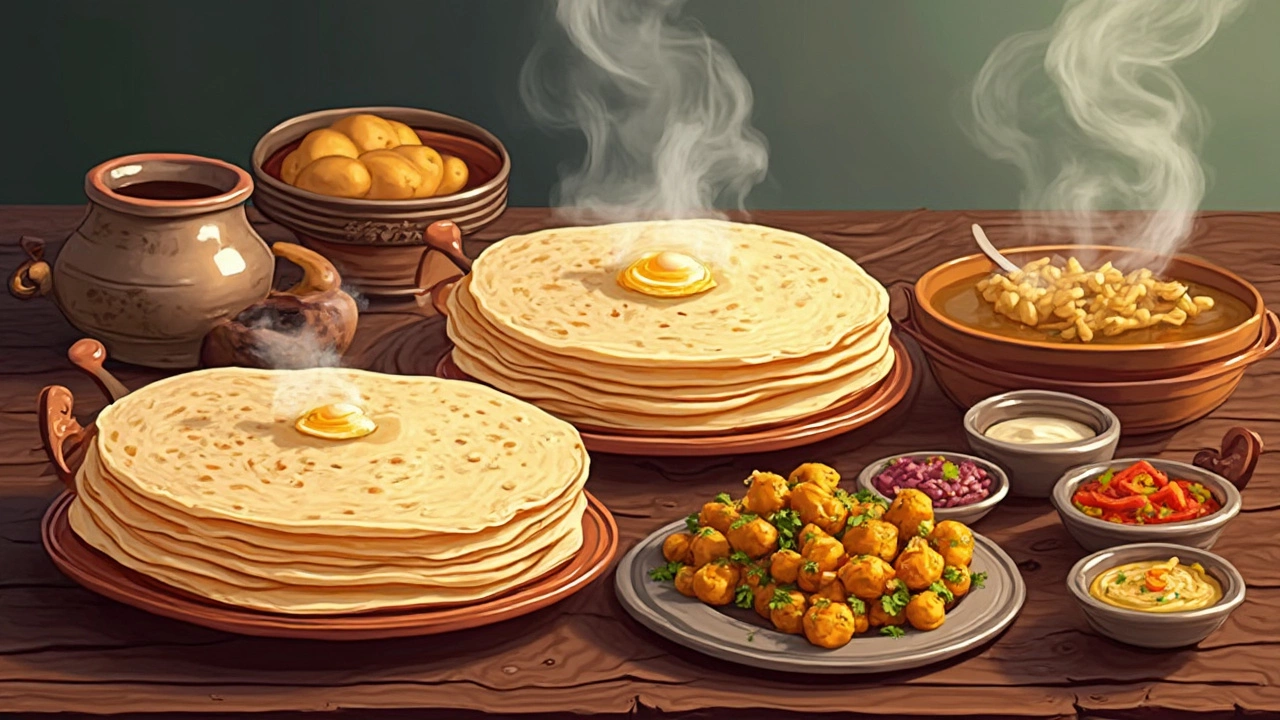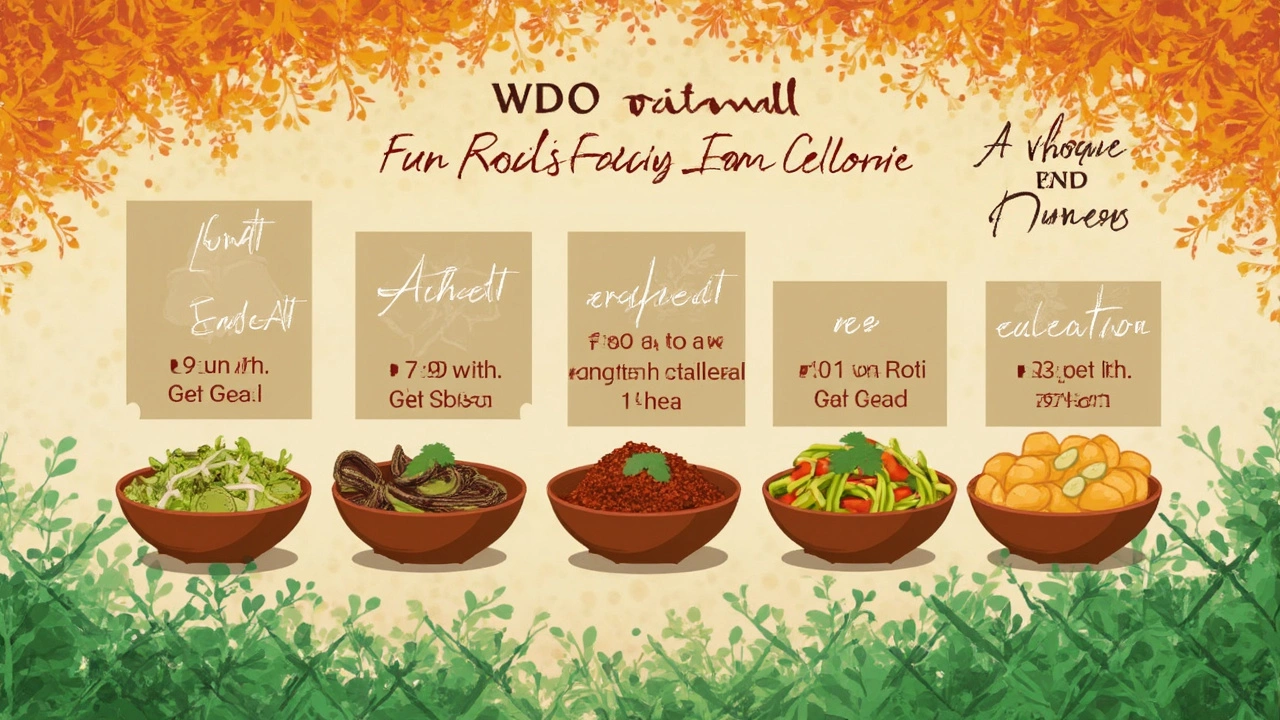Calories in 1 Roti: Understanding Your Daily Diet
 Feb, 16 2025
Feb, 16 2025
If you've ever wondered how the simple roti fits into your daily calorie intake, you're not alone. This round flatbread is a staple across many Indian households, and knowing its nutritional profile can be a game changer for anyone watching their diet. So, how much calories are in 1 roti? Well, a plain roti made from whole wheat flour contains roughly 70-80 calories. Of course, the exact number can vary slightly depending on the size and thickness.
Now, if you add a dollop of ghee right after cooking, it ups the ante, adding about 30-40 more calories. So, a roti with ghee jumps to around 100-120 calories. Pair that roti with a portion of sabzi, and your meal can quickly add up to 250 calories or more, depending on the preparation.
Balancing taste and calorie intake may seem challenging, but there are practical ways to enjoy your meal without going overboard. The key is moderation and being informed about what goes into your food. In the sections that follow, we'll provide detailed insights and strategies to help you navigate these choices easily.
- Understanding Roti and Its Ingredients
- Breaking Down Calories in 1 Roti
- The Impact of Ghee on Calorie Count
- Combining Roti with Sabzi
- Practical Tips for Managing Calorie Intake
Understanding Roti and Its Ingredients
Roti, a classic component of Indian cuisine, can seem simple but is packed with nutrition. Made primarily from whole wheat flour, it's a great source of fiber and essential nutrients. But what exactly goes into making this everyday staple?
Basic Ingredients of Roti
The mainstay of roti is whole wheat flour, known for containing more nutrients than refined flours. Other ingredients include water and a pinch of salt.
- Whole Wheat Flour: This is the star of the show. It's packed with fiber which helps digestion and keeps you full longer.
- Water: Essential to bind the dough, ensure it’s soft yet firm.
- Salt: A tiny amount enhances the taste without adding extra calories.
Substitutes and Variations
Looking for a twist? Try mixing in buckwheat or chickpea flour to amp up the protein and nutritional profile. Remember, though, this can alter the calories in 1 roti slightly.
Problems with Ingredients
For those with gluten sensitivities, whole wheat rotis could be problematic. A gluten-free mix can solve this. Substitute with gluten-free flours and follow a similar preparation method. Just be cautious with consistency, as gluten-free mixes can dry out quickly.
Preparation Tips for the Perfect Roti
- Combine flour, water, and salt, kneading until smooth. Let it rest to soften.
- Roll the dough into even balls, then flatten with a rolling pin.
- Cook on a hot tawa (iron griddle) until brown spots appear, then flip.
- Optionally, brush with a touch of ghee for flavor, keeping in mind the added calories in 1 roti with ghee.
Understanding the ingredients and preparation process can help you not just manage but create an enjoyable eating experience. Whether adjusting caloric intake or modifying for dietary restrictions, there's a blend for everyone.
Breaking Down Calories in 1 Roti
Roti is a staple in many diets, yet not everyone knows what's hiding within each fluffy disk. So, how does it break down, calorie-wise? The primary ingredient in roti is whole wheat flour, which is packed with nutrients and generally considered a healthier flour option.
Understanding Roti's Basic Calorie Content
On average, a plain roti, which weighs about 40-50 grams, contains around 70-80 calories. This doesn't seem much, right? And it's not, especially if you're pairing it with something nutritious. But these numbers can vary slightly based on how thick you roll the dough or how much oil you use during preparation.
Factors Affecting Calorie Count
- Thickness and Size: A thicker roti made with more dough will naturally have more calories.
- Cooking Method: Using oil or ghee in the pan can increase the calorie count.
- Type of Flour: Different types of flour, such as millet or mixed grains, might alter the calories slightly.
Nutritional Value of Roti
Beyond just the calorie content, roti offers a decent nutritional profile. It provides complex carbs for energy, and a bit of protein from the wheat. Plus, it's a great source of dietary fiber, which is essential for digestion.
Managing Calorie Intake
If you're watching your weight, you might wonder how many rotis should be on your plate. Start by assessing your daily calorie needs, which differ based on your activity level and goals. A balanced meal might include one or two rotis paired with a serving of veggies or protein, keeping the overall calorie count in check.
Remember, the key to enjoying roti without exceeding your calorie budget is moderation and balance. As long as you're aware of what goes into your meals and make conscious choices about portion sizes, you can savor every bite.

The Impact of Ghee on Calorie Count
Let's talk about ghee, a beloved ingredient in Indian cooking. While it's known for enhancing the flavor of dishes, it can also significantly impact the calorie count of your meals. Adding just one teaspoon of ghee to your roti adds approximately 45 calories. That means if you usually consume three rotis, the ghee alone could contribute 135 extra calories.
Why does this matter? Well, a typical adult's daily calorie requirement ranges from 1,800 to 2,200 calories. It adds up quickly, especially if you're not mindful of portion sizes. But that doesn't mean you have to cut out ghee altogether. Moderation is key.
How can you enjoy the flavor of ghee without overloading on calories? Try these simple tips:
- Use a spray bottle to lightly coat your roti instead of spreading with a spoon.
- Limit yourself to ghee on just one of your rotis if you're having more than one.
- Experiment with alternative spreads like olive oil, which are lower in saturated fat.
But don't just take my word for it. According to Dr. Ramesh Kumar, a renowned nutritionist,
"Ghee can be part of a healthy diet if consumed in moderation. It's a good source of essential fatty acids, which are important for brain function and hormone regulation."
Remember, enjoying your food is just as important as watching the calories in 1 roti. With a few mindful adjustments, you can have the best of both worlds: taste and health. Next time you feel like adding ghee to your roti, consider these tips to keep your meal balanced and satisfying.
Combining Roti with Sabzi
Pairing roti with a side of sabzi is a delightful combo that many of us can't resist. But how does this popular dish stack up nutritionally? Everyone's curious about the calories in 1 roti and sabzi, and rightly so. Let's break it down.
The Basics: Roti and Sabzi Mix
On its own, a plain roti contains about 70-80 calories, as we've seen. Add a typical serving of sabzi, which ranges anywhere from 150 to 200 calories depending on the ingredients and cooking method, and your meal could be around 250-280 calories in total.
Making Healthier Choices
If you love sabzi with root vegetables such as potatoes, be mindful that these tend to be higher in calories. Consider veggies like spinach or cauliflower, which are more calorie-friendly.
- Be mindful of oil: Opt for a non-stick pan or use minimal oil in preparation to keep the calories in check.
- Go for grilled or steamed: Cooking methods matter. Steamed veggies or grilled options can save you some calories.
- Spice it up healthily: Use spices and herbs—it adds flavor with no extra calories!
Balanced Meal Approach
A well-balanced roti-sabzi meal could include a side of dahi (yogurt) or a salad, which can help you feel fuller without significantly adding to the calorie count. Did you know that a cup of plain yogurt adds roughly 59 calories but gives you that needed protein punch?
| Meal Component | Calories |
|---|---|
| 1 Roti | 70-80 |
| 1 Bowl Sabzi | 150-200 |
| 1 Cup Yogurt | 59 |
This table gives you a bird's-eye view of what you're consuming. Managing your intake with some mindful swaps and additions could make your favorite meal both tasty and health-conscious.

Practical Tips for Managing Calorie Intake
We all love a good meal, but keeping our calories in check can sometimes feel like walking a tightrope. Here’s how you can enjoy your meals while managing your calorie intake effectively.
Know Your Portions
Understanding portion sizes is crucial. A single roti typically clocks in at 70-80 calories. Try to stick to regular-sized rotis instead of hefty variations. This simple adjustment helps keep your daily calories in balance.
Mindful Addition of Ghee
If you enjoy that rich taste of roti with ghee, apply it sparingly. Use a small spoon or brush to control the amount. This way, you'll get the flavor with less than 30 extra calories.
Calorie-Conscious Pairing
Combining roti and sabzi can make for a nutritious meal. Prioritize lighter, veggie-rich sabzis like spinach or mixed vegetables to keep meals nutritious but not calorie-heavy. When cooking, opt for techniques like steaming or grilling over deep frying.
Maintain a Food Journal
Keeping track of what you eat helps identify patterns. You might notice that a little more of this or that throughout the day adds up. A straightforward app or notebook can go a long way in helping you adjust portions or ingredients.
Stay Active
While managing your diet is essential, complementing it with some form of exercise is equally important. Whether it's a brisk walk or yoga, staying active helps balance out those delicious meals while promoting overall well-being.
By following these steps, you can continue to enjoy meals without worrying too much about how many calories are in 1 roti or its pairings. Remember, a little planning goes a long way in making healthier choices.